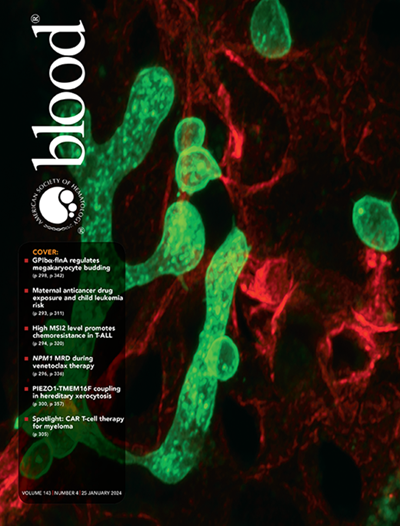Sclerotic GVHD and Scleroderma Share Dysregulated Gene Expression that is Ameliorated by EREG Therapeutic Antibody.
IF 23.1
1区 医学
Q1 HEMATOLOGY
引用次数: 0
Abstract
Immune driven fibrotic skin diseases including scleroderma/systemic sclerosis (SSc) and chronic graft-versus-host-disease (cGvHD) cause skin stiffening that has major impact on patient quality of life and associated patient mortality. Therapies to improve sclerotic skin resulting from these diseases are largely ineffective. We previously showed that EREG, a DC3 dendritic cell-derived EGFR ligand, is elevated in the skin and lung of patients with SSc and required for maintenance of skin fibrosis. Here, we developed a fully human anti-EREG neutralizing antibody that has both high affinity and specificity. We found this therapeutic antibody to be functional and safe in vivo using human EREG knock-in mice. To understand the antifibrotic mechanism of targeting EREG, we aligned skin single-cell transcriptomic profiles of SSc, morphea (localized scleroderma) and SclGvHD with disease biomarkers. EREG expression in the skin was elevated in all three fibrotic diseases and a driver of TNC production by myofibroblasts in all three fibrotic diseases. TNC is a pro-inflammatory extracellular glycoprotein that functions as an endogenous TLR4 ligand which induces expression of TLR4 target genes CCL2 and IL6. Examination of skin explants from patients with active SclGvHD treated with anti-EREG therapeutic antibody by spatial transcriptomics demonstrated upregulation of matrix degradation by increased MMP and decreased TIMP1 expression. Protein measurements showed reduced secretion of EREG targets TNC, CCL2, and TIMP1 in all patients, and type I collagen and FN1 in 3/4 patients. Thus, sclerotic skin treated with the anti-EREG therapeutic antibody reduced inflammatory and fibrosis biomarkers associated with EGFR and TLR4 signaling.硬化性GVHD和硬皮病共享基因表达失调,可通过EREG治疗抗体改善。
免疫驱动的纤维化皮肤病包括硬皮病/系统性硬化症(SSc)和慢性移植物抗宿主病(cGvHD)导致皮肤硬化,对患者的生活质量和相关的患者死亡率有重大影响。改善由这些疾病引起的皮肤硬化的疗法基本上是无效的。我们之前的研究表明,EREG(一种DC3树突状细胞衍生的EGFR配体)在SSc患者的皮肤和肺中升高,并且是维持皮肤纤维化所必需的。在这里,我们开发了一种具有高亲和力和特异性的全人源抗ereg中和抗体。我们发现这种治疗性抗体在人EREG敲入小鼠体内是有效和安全的。为了了解靶向EREG的抗纤维化机制,我们将SSc、morphea(局限性硬皮病)和SclGvHD的皮肤单细胞转录组谱与疾病生物标志物进行了对比。在所有三种纤维化疾病中,皮肤中的EREG表达均升高,并且在所有三种纤维化疾病中,肌成纤维细胞产生TNC的驱动因素。TNC是一种促炎细胞外糖蛋白,作为内源性TLR4配体,诱导TLR4靶基因CCL2和IL6的表达。通过空间转录组学检测抗ereg治疗性抗体治疗的活动性SclGvHD患者的皮肤外植体,发现MMP增加,TIMP1表达降低,从而上调基质降解。蛋白检测显示,所有患者的EREG靶蛋白TNC、CCL2和TIMP1分泌减少,3/4患者的I型胶原蛋白和FN1分泌减少。因此,用抗ereg治疗性抗体治疗硬化皮肤可减少与EGFR和TLR4信号相关的炎症和纤维化生物标志物。
本文章由计算机程序翻译,如有差异,请以英文原文为准。
求助全文
约1分钟内获得全文
求助全文
来源期刊

Blood
医学-血液学
CiteScore
23.60
自引率
3.90%
发文量
955
审稿时长
1 months
期刊介绍:
Blood, the official journal of the American Society of Hematology, published online and in print, provides an international forum for the publication of original articles describing basic laboratory, translational, and clinical investigations in hematology. Primary research articles will be published under the following scientific categories: Clinical Trials and Observations; Gene Therapy; Hematopoiesis and Stem Cells; Immunobiology and Immunotherapy scope; Myeloid Neoplasia; Lymphoid Neoplasia; Phagocytes, Granulocytes and Myelopoiesis; Platelets and Thrombopoiesis; Red Cells, Iron and Erythropoiesis; Thrombosis and Hemostasis; Transfusion Medicine; Transplantation; and Vascular Biology. Papers can be listed under more than one category as appropriate.
 求助内容:
求助内容: 应助结果提醒方式:
应助结果提醒方式:


